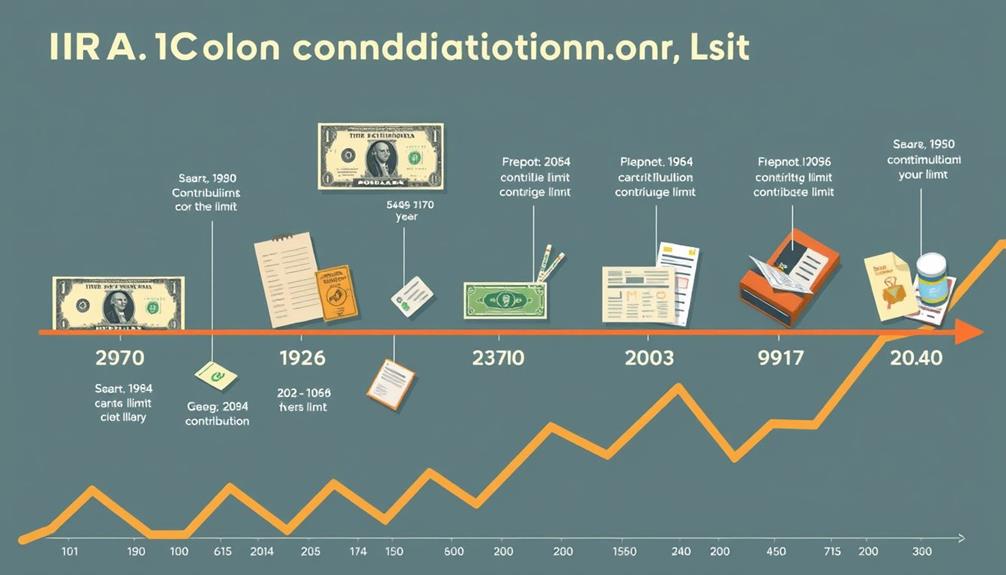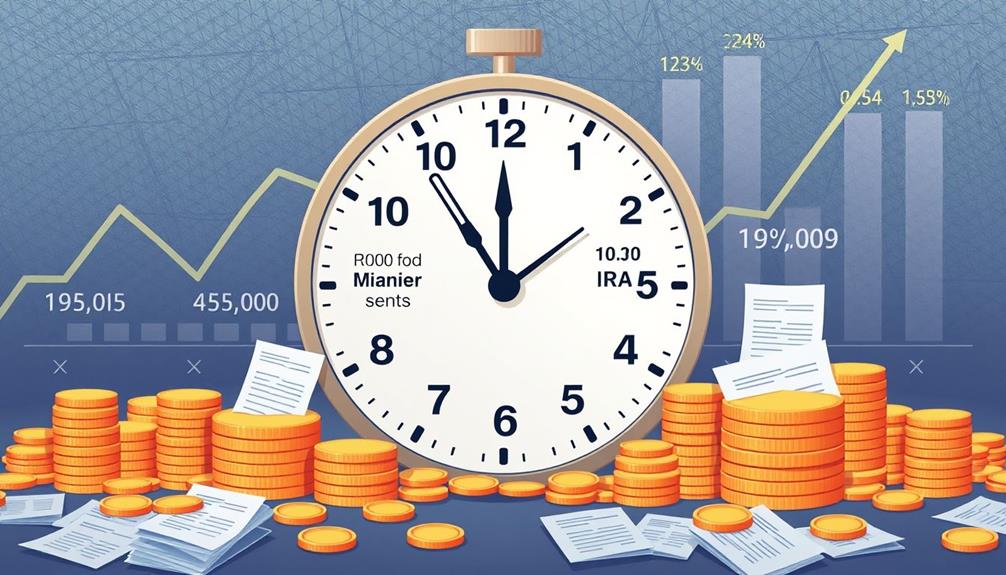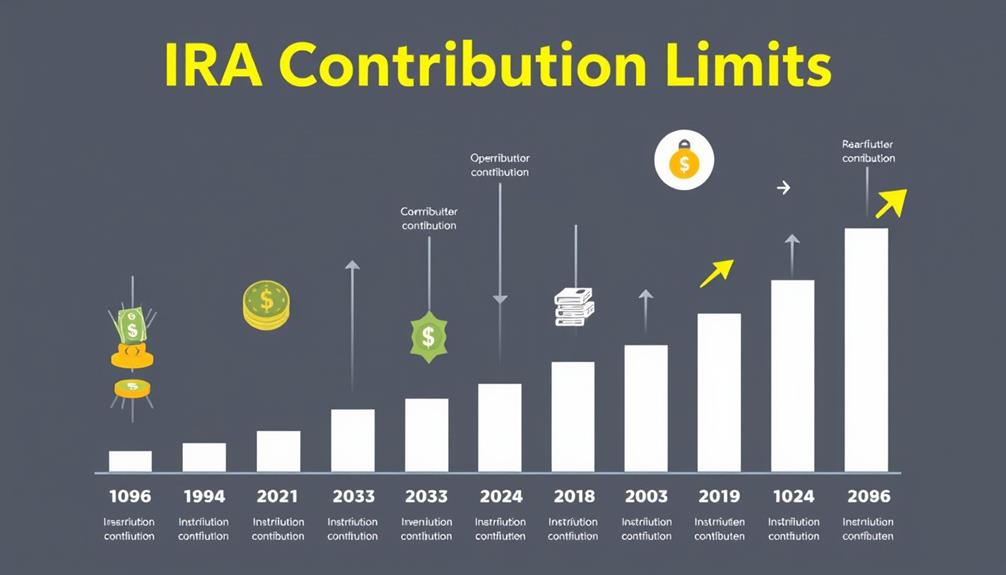IRA contribution limits have undergone significant changes since they were first introduced in 1974. Originally established at $1,500, they were increased to $2,000 by 1982. As of 2023, the limit stands at $6,500 for individuals under 50, with a rise to $7,000 in 2024. If you are over 50, you have the option to contribute up to $7,500 in 2023 and $8,000 in 2024, thanks to catch-up contributions. Any future adjustments will be determined by inflation and cost-of-living indexes. It’s vital to stay informed about these limits as they can have an impact on your retirement savings strategy. Make sure to understand how the upcoming changes could affect you in the future.
Key Takeaways
- IRA contribution limits have evolved from $1,500 in 1974 to $6,500 in 2023, with increases tied to inflation adjustments since 2001.
- For 2024, contribution limits will rise to $7,000 for individuals under 50 and $8,000 for those 50 and older.
- Catch-up contributions for individuals aged 50 and older allow an additional $1,000, increasing total limits to $7,500 in 2023 and $8,000 in 2024.
- Future IRA limits will continue to be based on annual cost-of-living adjustments, influenced by the Consumer Price Index (CPI).
- Awareness of income thresholds and phase-out ranges is crucial for maximizing contributions and avoiding penalties for excess contributions.
Historical Overview of IRA Limits

When you look back at the history of IRA contribution limits, it's clear how much they've evolved since their inception. Initially set at $1,500 in 1974, the IRA contribution limit rose to $2,000 by 1982. These limits reflect historical trends influenced by legislative changes and economic conditions.
Significantly, understanding financial terminology can help individuals better navigate their retirement planning. Fast forward to 2023, where the limit for individuals under 50 reached $6,500, with projections of $7,000 for 2024.
In 1997, the introduction of the Roth IRA added a new dimension to retirement savings. This allowed for after-tax contributions, making tax-free withdrawals in retirement a viable option.
Since 2001, the IRA contribution limits have been indexed to inflation, enabling cost-of-living adjustments that help keep pace with changing economic circumstances.
These adjustments signify a growing recognition of the importance of retirement savings, adapting to the financial realities faced by individuals.
Current Contribution Limits

For the tax year 2023, you can contribute up to $6,500 to your IRA if you're under 50, while those 50 and older can add $7,500.
It's important to reflect on how diversification strategies, such as investing in a Gold IRA, can enhance your retirement portfolio during periods of economic instability diversification strategies.
Looking ahead to 2024, these limits will increase to $7,000 and $8,000 respectively.
It's important to keep these limits in mind to maximize your retirement savings without incurring penalties.
2023 Contribution Limits
Here's a quick overview of the current contribution limits for 2024, which can significantly impact your retirement planning and investment strategies, especially when considering options like a Gold IRA for diversification and protection against inflation specializes in Gold IRAs:
- Individuals under 50 can contribute a maximum of $7,000 to their IRAs.
- Those aged 50 and older can make catch-up contributions, raising their limit to $8,000.
- Roth IRA contributions for single taxpayers phase out between incomes of $146,000 and $161,000.
- For married couples filing jointly, the phase-out range is $230,000 to $240,000.
- The SIMPLE retirement account contribution limit has increased to $16,000, up from $15,500.
These adjustments provide greater flexibility for your retirement savings strategy.
Be sure to consider these contribution limits when planning your IRA contributions for the year. Staying informed about changes like these helps you maximize your savings potential and achieve your long-term financial goals.
The IRS Notice 2023-75 offers comprehensive details about these changes, and it's worth reviewing as you prepare for the upcoming tax year.
Future Limit Projections
As you plan for your retirement, it's important to stay ahead of potential changes in IRA contribution limits. For 2024, the IRA contribution limit rises to $7,000 for individuals under 50 and $8,000 for those aged 50 and older, which includes a $1,000 catch-up contribution.
These adjustments to the contribution amount are vital for your retirement savings strategy, especially as inflation impacts your future needs.
The IRS bases any future changes on the annual cost-of-living, using the Consumer Price Index (CPI) for the fiscal year. This indexing guarantees that contribution limits remain relevant and responsive to economic conditions.
You can expect the IRS to release the official limits for 2025 in October or November 2024, once the CPI figures are finalized.
Understanding these potential increases allows you to maximize your retirement savings effectively. Stay informed about these projections, as they can greatly impact your financial planning.
Age-Specific Contribution Rules

As you approach age 50, you gain the opportunity to make catch-up contributions to your IRA, boosting your savings potential.
This rule also applies to spousal IRA contributions, allowing your non-working partner to benefit from your earnings.
Understanding these age-specific rules can help you maximize your retirement savings effectively.
Catch-Up Contributions Explained
Catch-up contributions provide a valuable opportunity for individuals aged 50 and older to boost their retirement savings when it matters most. By allowing extra contributions to IRAs and employer-sponsored plans, these provisions help you enhance your retirement accounts as you approach retirement.
For the tax year 2024, here's what you need to know about catch-up contributions:
- IRA Limit: You can contribute an extra $1,000, raising your total IRA contribution limit to $8,000.
- 401(k) Limit: For employer-sponsored plans, the catch-up contribution limit is $7,500.
- Additional Savings: These contributions are in addition to regular contributions, greatly increasing your savings potential.
- Recovery Tool: The catch-up provision is designed to help you recover missed retirement savings opportunities due to life circumstances.
- Age-Specific: Tailored for those aged 50 and older, this option acknowledges the unique financial needs of older workers.
Utilizing catch-up contributions can make a substantial difference in your retirement preparedness, ensuring you're on track to meet your future financial goals.
Don't miss out on this valuable resource!
Age 50 and Older
Individuals aged 50 and older have specific contribution rules that can greatly enhance their retirement savings. For 2023, the maximum IRA contribution limit is $7,500, which includes a $1,000 catch-up contribution above the standard limit of $6,500. This provision allows you to accelerate your savings as you approach retirement.
In 2024, that limit increases to $8,000, providing even more opportunity for you to bolster your retirement funds. The catch-up contributions aren't limited to just IRAs; you can also make them to employer-sponsored retirement plans like 401(k) and 403(b) plans. This flexibility means you can maximize your overall retirement savings strategy.
These age-specific contribution rules reflect a broader initiative to support older workers in building adequate retirement funds. As you near retirement age, leveraging these catch-up contributions can help you recover missed investment opportunities and enhance your financial security.
Spousal IRA Contributions
Spousal IRAs provide a valuable opportunity for non-working spouses to contribute to their retirement savings based on the working spouse's income. This allows you to maximize your retirement savings, even if you don't have earned income yourself.
For 2024, the contribution limits are significant:
- $7,000 for individuals under 50
- $8,000 for individuals aged 50 and older (due to catch-up contributions)
- Each spouse can contribute to their own IRA
- Total contributions can't exceed the working spouse's taxable compensation
- Deductibility of contributions to a traditional IRA may be limited if either spouse has a retirement plan at work
For married couples filing jointly, the income phase-out range for 2023 is $123,000 to $143,000 if one spouse is covered by a retirement plan.
If your combined income falls within this range, it could affect your ability to deduct contributions to your traditional IRA.
Understanding these rules guarantees that you can effectively plan for your future retirement while taking full advantage of spousal IRAs and their contribution limits.
Spousal IRA Contributions

If you're looking to boost your retirement savings, a spousal IRA can be an excellent option. This unique account allows a non-working spouse to contribute to an IRA, ensuring that both partners can maximize their retirement funds even if one doesn't have taxable income.
For the tax year 2024, you can contribute up to $8,000 if you're 50 or older, which includes a $1,000 catch-up contribution.
Both spouses can take advantage of the contribution limits, but your combined contributions can't exceed your total taxable compensation.
It's essential to recognize that if neither of you participates in an employer-sponsored retirement plan, both can fully deduct contributions to a traditional IRA regardless of your income levels. However, if one spouse is part of such a plan, the deductibility may be limited based on your combined income.
Utilizing a spousal IRA can greatly enhance your retirement strategy, allowing you to prepare for the future together.
Make sure to explore this option as you consider your overall retirement savings plan!
Impact of Employer Plans

Employer-sponsored retirement plans can greatly impact your ability to contribute to an IRA, especially when it comes to deductibility. If you're participating in an employer plan, your income level will determine how much of your traditional IRA contributions are deductible.
Here's what you need to know:
- Traditional IRA Phase-Outs: For 2023, single taxpayers with an employer plan face a phase-out range of $77,000 to $87,000.
- Married Couples: For couples filing jointly, if one spouse is covered by an employer plan, the phase-out range is $123,000 to $143,000.
- Roth IRA Limitations: Contributions to a Roth IRA may also be limited based on income, with single taxpayers facing a phase-out range of $146,000 to $161,000.
- Contribution Flexibility: You can still make contributions to traditional or Roth IRAs even if you're part of an employer-sponsored retirement plan.
- Retirement Strategy: Understanding these thresholds is essential for effective retirement planning.
Be aware of these implications when planning your contributions to guarantee you maximize your retirement savings.
Excess Contribution Penalties

Understanding your contribution limits is fundamental, especially when considering the potential penalties for excess contributions. If you exceed the annual limit for your IRA, you could face a 6% tax penalty on the excess amount for every year it remains in your account. For 2023, the contribution limits are $6,500 for individuals under 50 and $7,500 for those aged 50 and older.
To avoid these tax penalties, it's important to withdraw any excess contributions, along with any income earned from them, by your tax return due date. Awareness of your limits is critical, especially if you have multiple accounts, such as Roth IRAs, to prevent unintentional excess contributions.
Here's a quick overview of the excess contribution penalties:
| Excess Contributions | Tax Penalty |
|---|---|
| Over $6,500 (under 50) | 6% of excess |
| Over $7,500 (50 and older) | 6% of excess |
| Amount withdrawn by due date | No penalty |
| Remaining in account | 6% each year |
Stay vigilant and make sure you stay within your limits to protect your savings.
Future Projections for 2025

As we look ahead to 2025, significant changes in IRA contribution limits are on the horizon, thanks in part to the SECURE 2.0 Act.
The new provisions aim to enhance your retirement savings, particularly if you're nearing retirement age. Here's what you can expect:
- Increased catch-up contributions for those aged 60-63, with a limit of the greater of $10,000 or 150% of the regular catch-up amount.
- Contribution limits for IRAs will be adjusted based on the inflation rate calculated from the Consumer Price Index (CPI) for 2024.
- The IRS will officially announce 2025 limits in October or November 2024.
- Projections will consider both past and anticipated CPI increases, influencing the maximum contribution amounts.
- These changes will apply to both Roth and traditional IRAs, allowing for greater flexibility in your savings strategy.
With these enhancements, you'll have more opportunities to maximize your contributions to traditional and Roth accounts, ensuring you're better positioned for a comfortable retirement.
Keep an eye out for the IRS announcements to stay informed about your contribution limits!
Catch-Up Contribution Benefits

Maximizing your retirement savings is essential, especially as you approach your golden years. If you're aged 50 or older, you have a unique advantage with catch-up contributions. These allow you to contribute an additional $1,000 to your individual retirement account (IRA), raising your total annual limit to $7,500 for 2023 and $8,000 for 2024. This provision is designed to help you recover missed investment opportunities and bolster your savings as retirement nears.
| Year | Contribution Limit | Catch-Up Contribution | Total Limit |
|---|---|---|---|
| 2023 | $6,500 | $1,000 | $7,500 |
| 2024 | $7,000 | $1,000 | $8,000 |
| 2024 (401(k)) | $23,000 | $7,500 | $30,500 |
Utilizing catch-up contributions can greatly enhance your retirement savings. For instance, if you contribute an additional $1,000 annually at a 6% return, it could grow to over $11,000 by age 65. Take advantage of this option to guarantee a more secure financial future.
Tax Implications of Contributions

Contributions to your IRA can greatly impact your tax situation, so it's important to navigate the rules carefully. Depending on whether you choose a traditional or a Roth IRA, the tax implications can vary greatly.
For traditional IRAs, contributions might be tax-deductible based on your income level and whether you participate in an employer-sponsored retirement plan. Be aware of the phase-out ranges that apply to different filing statuses.
In contrast, Roth IRA contributions are made with after-tax dollars, meaning you won't get a tax deduction upfront, but your qualified withdrawals will be tax-free in retirement.
Here are some key points to remember:
- Excess contributions incur a 6% annual penalty tax.
- You must withdraw excess contributions by the tax return due date to avoid penalties.
- Income tax applies to earnings on excess contributions unless withdrawn.
- Understanding your Modified Adjusted Gross Income (MAGI) is vital.
- IRA catch-up contributions can enhance your savings while considering tax implications.
Frequently Asked Questions
Will IRA Contribution Limits Increase in 2024?
Yes, IRA contribution limits will increase in 2024. You'll be able to contribute $7,000 if you're under 50, and $8,000 if you're 50 or older, plus adjustments for Roth IRA phase-out ranges.
What Is the 2025 IRA Contribution Limit?
Like a tree growing stronger each year, your IRA limits may increase. You'll find the 2025 contribution limit set in late 2024, influenced by inflation, likely following the 2024 limits of $7,000 and $8,000.
When Should You Stop Contributing to an Ira?
You should stop contributing to an IRA if your income exceeds the phase-out thresholds, you're facing financial strain, or when your retirement income sources become sufficient. Prioritize your current cash flow and emergency savings instead.
What Are the 401(K) Changes for 2025?
Ready to boost your retirement savings? In 2025, 401(k) contribution limits rise to $23,500, with catch-up contributions for those 50+ reaching $8,000, and even higher limits for ages 60-63. Start planning now!
Conclusion
As you navigate the ever-changing landscape of IRA contribution limits, think of it like steering a boat through shifting tides. Just as a seasoned sailor adjusts their sails to harness the wind, you can adapt your contributions to maximize your retirement savings. With the right knowledge and strategies, you can set a course toward a secure financial future. Keep an eye on upcoming changes and don't hesitate to take advantage of catch-up contributions—they're your wind in the sails!









